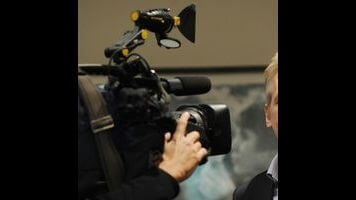Frontline: “Money, Power And Wall Street”

For all the misery it’s unleashed, the financial meltdown of 2008 has had at least one teensy, weensy upside: It’s inspired some brilliant reporting, from outlets like This American Life, Vanity Fair, Rolling Stone, and 60 Minutes, among many, many others. Then there’s investigative stalwart Frontline, which has already produced at least four different specials related to various aspects of the crisis and its unfortunate spinoff, the Madoff scandal.
Now, almost four years after the collapse of Lehman Brothers, Frontline is back with a super-sized, four-hour series on the crisis called “Money, Power and Wall Street” (with a title like that epic, four hours hardly seems like enough). The first two parts, which air tonight, cover the events leading up to and immediately after the fall of Lehman in September 2008; the second two parts, airing next week, are an appraisal of what we’ve learned—or haven’t—from the disaster.
As someone who only somewhat recently wrapped my head around the difference between a “stock” and a “bond,” I always welcome insightful, accessible journalism about economic subjects. There’s something especially satisfying, in a self-congratulatory, finger-wagging kind of way, about anything on the financial crisis: Those idiots on Wall Street! What were they thinking? Of course credit default swaps are crazy! It’s legal gambling! What madness! I guess what I mean to say is that great reporting makes you feel like a sort of instant expert, albeit in hindsight.
The first of tonight’s two parts, from correspondent Martin Smith, does just that. Despite a dizzying amount of talk about “synthetic collateralized debt obligations” and various other scary things referred to rather euphemistically as “exotic financial products,” the report strikes the right balance between accessible and informative. As a financial neophyte, I get the most out of reporting that distills a vast, complicated subject—and all that incomprehensible jargon—into a discrete human narrative (one of the reasons that This American Life’s work on the credit crisis has been so great is because it did just that). Part one of “Money, Power and Wall Street” tells the story of the real estate bubble and the global meltdown from the perspective of a group of ambitious, 20something bankers in J.P. Morgan’s global derivatives group.
At a 1994 company retreat in Boca Raton (where all terrible things begin), the young bankers invented a new financial product: the credit default swap, which encouraged lending by insuring banks against loan default. It caught on, and within a few years, J.P. Morgan and other banks were making billions of dollars off of the new—and almost entirely unregulated—market, and even trading the risk itself as a kind of derivative. Eventually, credit default swaps, which were initially intended only for use by banks and other large corporations, were applied to consumer debt—especially mortgages. Once the risk was removed, more national banks were willing to get into the subprime mortgage game, previously the domain of smaller, shadier lenders.
This, you may not be surprised to learn, is where things really started to go wrong. Smith interviews several original members of J.P. Morgan’s global derivatives group, who recall how their innovation had, as one of them puts it, become a kind of “Frankenstein’s monster.” “Suddenly we found ourselves with a product that was vastly different from where we started. Every little tweak along the way, we’d said, ‘That’s OK.’ Suddenly, we said, ‘That’s not OK,’” recalls Terri Duhon, one of the original J.P. Morgan bankers. There was a widespread sense that no one really understood the potential ramifications of these increasingly complex products, but as long as business was booming, any attempt at regulation—including a 2002 bill to curtail predatory lending in Georgia—was met with fierce resistance.
We all know what happened next, of course. But the report does an outstanding job illustrating how something as seemingly benign as a corporate retreat in Boca Raton can have such devastating and unintended consequences. The hour ends on an equally evocative note, with a visit to the abandoned houses and subdivisions that blight places like Atlanta and Las Vegas, properties that could be sold if only someone knew who actually owned them.
The second part of “Money, Power and Wall Street” doesn’t quite deliver in the same way, despite the instant gravitas provided by Will Lyman’s narration. The hour focuses on the months between the collapse of Bear Stearns and the allocation of TARP money in October 2008—a time span that includes the so-called “summer of assurances.” It is highly critical of Hank Paulson and, to a lesser extent, Tim Geithner, who failed to prepare for another banking failure in the wake of Bear Stearns and were caught flat-footed by the fall of Lehman. There’s also a lengthy account of the meeting held in Washington DC days after Lehman’s collapse—the one John McCain “suspended” his campaign for, you may recall. McCain fumbled with his index cards, while Obama wowed everyone with his command of the subject matter. Despite an impressive roster of interviews with heavyweights like Paul Krugman, Ron Suskind, and John Thain, the second hour of the report doesn’t shed a great deal of new light on the jittery weeks of crisis after the meltdown.
There’s also a lack of narrative and stylistic continuity from one hour to the next—an inevitability, I suppose, since they were put together by a different team of producers. It’s not a huge problem, but it does create a slightly disjointed effect. Grading a show like Frontline always seems somewhat beside the point (“I think Geithner is an intriguing character, but Paulson's really not working for me”), but it feels especially so in this case, since we’re still only halfway through the documentary and can’t fully evaluate the arguments it’s making. I’d like to say I’m looking forward to next week, but something tells me it’s not exactly going to instill me with confidence.